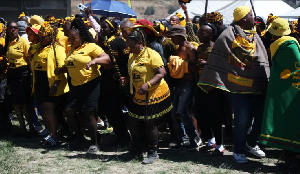 Members of Terene, a Lesotho gang rooted in Famo music, a local form of hip-hop tied to violence
Members of Terene, a Lesotho gang rooted in Famo music, a local form of hip-hop tied to violence
On a sunny afternoon, a white minibus taxi carrying 22 passengers pulled out of a crowded bus station in Johannesburg and headed to neighbouring Lesotho, the landlocked kingdom inside South Africa’s borders.
The moment the minibus got on the highway, the driver switched on the radio and the speakers crackled to life with the sound of a solo accordion – the intro to a well-known Famo song.
“I could listen to this music all day,” said one passenger, a young man in blue workman overalls, but worn stylishly to make a fashion statement instead of for industrial use. Around him, many other passengers, most Lesotho nationals, bobbed their heads and sang along as the drums and vocals on the track kicked in.
Famo, a genre of music that blends traditional Southern African songs and Western instruments, first emerged a century ago among migrant mining communities in South Africa. The music, characterised by heavy use of the accordion fused with guitar picking from the maskandi style, a subgenre of Zulu folk music, is greatly loved by many Basotho.
But in recent years, Famo has become notorious beyond dance halls and concert venues. Fierce rivalry between some fans and singers has caused deadly gang warfare in Lesotho. Recently, the violence has exacerbated so much that the government banned some Famo groups and branded them “terrorist” organisations.
Now many die-hard fans are unable to watch their favourite artists perform live. “I love Famo music,” says Thabelo, a taxi driver in Maseru who we are not naming as many people are now nervous to speak publicly about the topic. “You know they have banned the shows now, so we can only play it in our cars or in the privacy of our homes.”
The ban, which went into effect in May, named specific Famo groups which the government called “unlawful by reason of being involved in, or promoting or encouraging subversive activities”. The ban extends to any paraphernalia associated with banned groups, such as stylish traditional blankets with distinct gang colours.
Some of the groups banned include the popular Terene ea Chakela and Terene ea Mokata-Lirope, among others.
However, groups or musicians not affected by the ban are free to perform, like Famo artist Mantsali Julia Hantsi, popularly known as Thope Tse Khang.
Famo music wasn’t always associated with violence and gangs, Hantsi told Al Jazeera, adding that historically, Famo music was a way for people to express themselves, celebrate, and tell stories.
“[Famo music] was a form of entertainment that also served to preserve the history and culture of the Basotho people,” she said. “Unfortunately, in more recent times, certain factions have used the music to incite violence or promote rivalry among themselves.”
‘Not about violence’
In July this year, two prominent voices at the forefront of the Famo scene were caught up in the worsening violence when unidentified gunmen opened fire on their van in Maseru and shot them.
Khopolo Khuluoe, popularly known as Lisuoa, was an award-winning singer of Famo, while Pulane Macheli was a celebrated radio personality. Together, they were on a quest to stop violence related to Famo music.
Instead, they became victims of the very thing they were trying so hard to stop – with Khuluoe killed instantly at the scene of the shooting and Macheli dying in hospital the following day.
In Lesotho, murders related to Famo music seem to have risen. This year alone, the media has reported several cases of Famo-related murders, including the family members of an alleged Famo gangster.
Many of the killings are connected to a longstanding feud between two major Famo gangs: the Terene ea Mokata Lirope group, and the Liala Mabatha gang. The two have been at each other’s throats for months.
In April, two members of the Terene group were shot at a funeral in their leader’s rural home in Leribe. Six hours later, a suspected revenge killing took place: five family members of a rival Famo gang member were killed.
No one has been charged for the murders but it is believed the killings are linked to the Terene and Liala Mabatha feud.
Hantsi feels disheartened about the new associations between Famo and violence. “This shift has cast a shadow on the genre,” she said, “but at its core, Famo is not about violence; it’s about storytelling and expression.”
Evolution of Famo
Famo music originated in the slum yards of Johannesburg in the 1920s, writes Lehlohonolo Phafoli in the academic article The Evolution of Sotho Accordion Music in Lesotho. Back then, it was mostly performed for drinkers of an illicit brew called “skokiaan” in illegal drinking spots for Black people, called “shebeens”.
Many visiting the shebeens, according to Phafoli, were Basotho nationals who joined throngs migrating to South Africa in search of work, which also included native Black South Africans dispossessed from their land under apartheid.
From South Africa’s townships, Famo made its way to Lesotho. Phafoli notes: “Famo music spilled over into Lesotho and became common in shebeens. Its arrival in Lesotho can be attributed to two major groups: first, migrant labourers, especially men, and second, Basotho women who came from the locations and mine compounds in Johannesburg”.